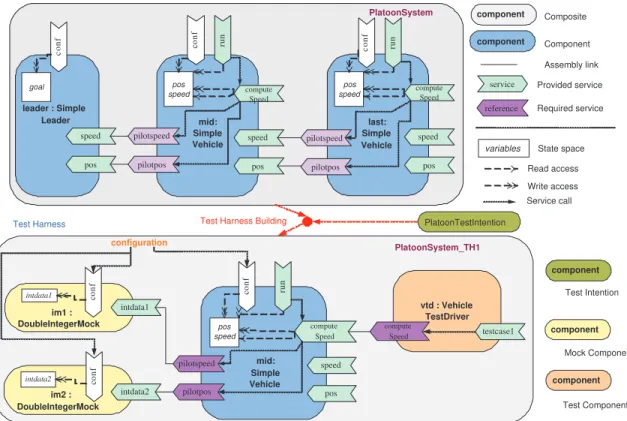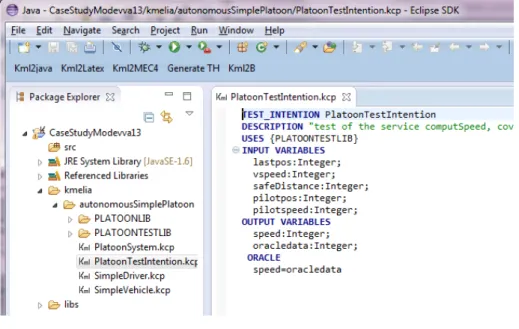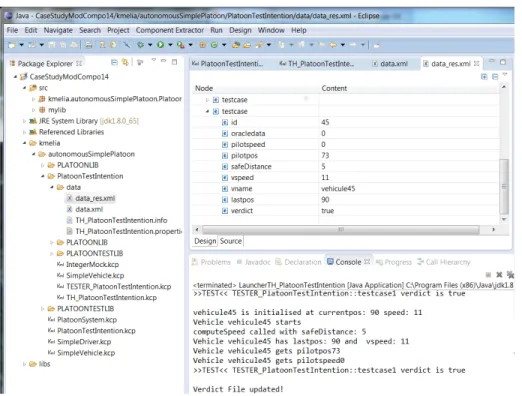HAL Id: hal-01436067
https://hal.archives-ouvertes.fr/hal-01436067
Submitted on 26 Apr 2017
HAL is a multi-disciplinary open access
archive for the deposit and dissemination of
sci-entific research documents, whether they are
pub-lished or not. The documents may come from
L’archive ouverte pluridisciplinaire HAL, est
destinée au dépôt et à la diffusion de documents
scientifiques de niveau recherche, publiés ou non,
émanant des établissements d’enseignement et de
COSTOTest: a tool for building and running test
harness for service-based component models (demo)
Pascal Andre, Jean-Marie Mottu, Gerson Sunyé
To cite this version:
Pascal Andre, Jean-Marie Mottu, Gerson Sunyé. COSTOTest: a tool for building and running test
harness for service-based component models (demo). ISSTA 2016 Proceedings of the 25th
Interna-tional Symposium on Software Testing and Analysis, Jul 2016, Saarbrücken, Germany. pp.437-440,
�10.1145/2931037.2948704�. �hal-01436067�
Demo:
COSTOTest: A Tool for Building and Running
Test Harness for Service-based Component
Models
Pascal Andr´
e
1, Jean-Marie Mottu
1,2, and Gerson Suny´
e
1,2 1LINA - University of Nantes, France
2
Inria, Mines Nantes
[pascal.andre,jean-marie.mottu,gerson.sunye]@univ-nantes.fr
April 26, 2017
Abstract
Early testing reduces the cost of detecting faults and improves the sys-tem reliability. In particular, testing component or service based syssys-tems during modeling frees the tests from implementation details, especially those related to the middleware. COSTOTest is a tool that helps the tester during the process of designing tests at the model level. It sug-gests the possibilities and the lacks when (s)he builds test cases. Building executable tests is achieved thanks to model transformations.
1
Introduction
Early testing reduces the cost of Verification and Validation (V&V) [1]. In Model-Driven Development (MDD), models describe the system and can be tested to validate its correctness [2]. Testing models reduces V&V complex-ity [3]: it helps to focus on platform-independent faults, which are costly cor-rected later (they can be spread in the code).
In [4], we considered early testing of Service-based Component (SBC) Mod-els to detect platform-independent errors i.e. at the model level. Testing such applications’ code is tricky due to the middleware information that implements communications. Nevertheless, testing such applications’ model introduces some problematics, that we considered in [4]. In particular, as mentioned by Vincenzi et al. [5], encapsulation decreases testability (i.e. observability and controlla-bility). Moreover, a tester should manage the dependencies between compo-nents, fulfilled by their services. Our contribution is an integrated and assisted
approach to build and to execute test cases on these models. Our approach provides assistance to explore the model elements still preserving encapsulation and dependencies.
Usually, a tester uses a test harness to provide the test data to the component under test, and to run the test cases. COSTOTest helps the tester in building such test harnesses. Our postulate is to consider a test harness like a plain SBC model: we therefore reuse the full SBC development tool kit (edition, validation, code generation). We promote testing models by models. This is different than following a model-based testing approach where models (e.g. UM models) are used to compute test suites that are implemented with deployment code (e.g. Java). This last approach has been considered by Rocha et al. [6]. Here the model testing approach considers the test on the models themselves.
This paper presents the COSTOTest tool, a practical answer to the problem of building and running test harnesses for Service-based Component Models. The demonstration overviews the approach and shows its feasibility. The tool provides facilities to bypass encapsulation in order to build executable test cases. The tool is available online at http://costo.univ-nantes.fr/.
2
Testing Models by Models
COSTOTest aims to assist testers during SBC testing [5, 7], assuming service’s contracts to improve the quality [8, 9].
We depict a motivating example at the top of Figure 1 : a platoon of vehi-cles (illustrated with an extended SCA notation [10]). A component system (a platoon) is an assembly of components (vehicles) which services are bound by assembly links. A component encapsulates its state with internal variables (own speed and position of a vehicle).
The interface of a component defines its provided and required services (each vehicle provides its speed and position to its follower which requires them). The interface of a service defines a contract to be satisfied when calling it. The service may communicate, and the assembly links denote communication channels. The set of all the services needed by a service is called its service dependency. The required services can then be bound to provided services.
Any provided service can require data: • internally to internal variables,
• internally to its own provided services (e.g. the service run requires the computeSpeed service to update the speed of its component),
• externally to required services in the component’s interface which are sat-isfied by other components (the service under test in the rest of the paper computeSpeed calculates the new speed of a component based on its speed, position, predecessor’s speed and position).
Build test harness as a model
A tester may test the service computeSpeed, which is associated to the com-ponent named mid with the following safety property: the distance between two
speed pos compute Speed c o n f ru n pos speed mid: Simple Vehicle leader : Simple Leader PlatoonSystem pilotspeed pilotpos speed pos speed pos compute Speed c o n f ru n pos speed last: Simple Vehicle pilotspeed pilotpos c o n f goal service reference component variables Assembly link Provided service Required service Service call Component State space Read access Write access component Composite component Test Component component Mock Component mid: Simple Vehicle im1 : DoubleIntegerMock vtd : Vehicle TestDriver compute Speed c o n f c o n f ru n pilotspeed pilotpos intdata1 compute Speed speed pos testcase1 pos speed PlatoonSystem_TH1 configuration intdata1 im2 : DoubleIntegerMock c o n f intdata2 intdata2 System Under Test
Test Harness Test Harness Building
Test Intention component PlatoonTestIntention
Figure 1: A test harness built from the Platoon system according to a test intention
neighbour vehicles is greater than a value safeDistance . The service behaviour is dependent on (i) the recommended safe distance from the predecessor, (ii) the position and speed of the vehicle itself and of its predecessor.
Testing the computeSpeed service of the component mid requires to affect encapsulated variables: give a value to its safeDistance parameter, initialise the values of the currentPos and currentSpeed variables, which are used by the compute Speed service, and find providers for pilotspeed and pilotpos which are required by computeSpeed.
The model of the test harness (bottom of Figure 1) is build from the System Under Test (SUT) e.g. the PlatoonSystem composite (top of Figure 1) and a test intention (middle of Figure 1). The test intention provides the list of which variables will be part of each test data (such as the above mentioned variables: position, speed, previous position, previous speed, and safe distance), and what would be the oracle data (such as the new own speed which is expected to have an expected value). It is provided by a TestIntention component.
COSTOTest helps the tester to (i) build the test harness (establish a consis-tent and complete context for testing) as illustrated by the bottom of Figure 1, and (ii) run the test cases with the test data values provided by the tester.
The advantages of testing models by models are those of early testing but also the possibility of reusing the rich modelling tools panel, and of providing an adequate framework for co-evolution between the System Under Test Model and the Test Harness model.
3
COSTOTest: a Testing Assistant
COSTOTest assists the tester in managing the way the test data can be pro-vided: some of them by the configuration service, other ones by mock compo-nents, and the oracle by a test driver, as illustrated at the bottom of Figure 1. To achieve this, the tool helps the tester:
• to select the services and components from the SUT model according to a test intention;
• to check the test harness assembly correctness and completeness, satisfying assembly constraints;
• to bind required services to mocks provided in COSTOTest libraries; • to check the test harness consistency and completeness regarding its test
intention (that may be improved/completed during the test harness build-ing);
• to generate a test component including the testcase services e.g. vtd in Figure 1;
• to launch the test harness with several test data values sets and to collect the verdicts. Test Harness Transformation SUT Model (PIM) Test Intention (TI) Test Execution Verdict Data source Harness + SUT (TSM) Code Mappings Transformation Operational Framework (PDM) Data
Figure 2: Testing process overview Model transformation approach
The testing process is a sequence on model transformations which succes-sively merge models, integrating features into them, as illustrated Figure 2. The input the System Under Test is a PIM (Platform Independent Model) of the SBC and a Test Intention is also a model described with a Domain Specific Language (DSL) cf. Figure 3. The process is made of two successive model transformations which return an executable code of the test harness.
The first model transformation is a model-to-model transformation. It builds the test harness as an assembly of selected part of the SUT with test compo-nents (mocks, test driver), and returns a Test Specific Model (TSM). It is semi-automatic: the test intention is provided by the tester and COSTOTest asks her/him to make choices, that are selected based on static analysis of the PIM. During this first step, the aim for the tester is to build a harness such as the one illustrated in the bottom of Figure 1 : PlatoonSystem TH1.
Figure 3: Test Intention
The second transformation is a model-to-code transformation, COSTOTest generates the code to simulate the behaviour of the harness. It merges the harness with a Platform Description Model (PDM) to get code (Java code in this case). It can be executed, because the model of the components describes the behaviour of the services, in the form of Communicating Finite State Machines. The test data and test oracle providers are designed in the PDM, thanks to the input “Data”. A “data source” is generated, it is an XML file, with a structure corresponding to the test intention, and that the tester should fulfil with concrete values.
Implementation
In the current version of COSTOTool, the models (PIM and TSM) are de-scribed with the Kmelia modelling language [9], and the PDM framework is writ-ten in Java with an ad hoc communication layer for services and components. We can develop other PDM dedicated to different implementation languages, and to support different modelling languages.
The PIM may include primitive types and functions (numbers, strings, I/O...) that must also be mapped to the code level. These mappings are predefined in standard libraries or defined by the user. High-level TSM primitives are
auto-matically connected to low level (PDM, code) functions, as illustrated in Fig-ure 4. If the mapping is complete and consistent, then the model is executable.
Figure 4: Test harness Concrete data and Function Mapping
COSTOTest exploits API features (1) to detect missing mappings between the TSM and the PDM, (2) to generate standard primitive fragments (e.g. idle functions, random functions). The mappings are stored in libraries in order to be reused later and the entries can be duplicated to several PDM.
Build such a test harness at the model level induces an additional effort (the models are not considered only to develop the service-based component’s implementation), but the errors detected are less expensive to solve than those of components and services once deployed on specific platforms. Moreover, if the component model is implemented several times targeting several different PDM, the tests would be reused and part of the behaviour would have been checked before runtime.
Finally, the test execution consists in setting the test data and then “run” the test harness component. COSTOTest proposes interactive screen to enter all the data values into the XML file generated by the second model transformation. She/He can also provide the test data values in a CSV file which is transformed into the XML file.
We perform experiments to study the effectiveness of our tool in testing ser-vices into components assembly. We consider the test of computeSpeed service, covering its control flow graph to generate test data. We create 45 test cases and run them getting the verdicts. The data source XML file will also store the verdicts (cf. Figure 5).
4
Related Work
There are several research efforts interested in generating tests for testing com-ponents.
Figure 5: Test harness assignments: verdict stored in the XML file
In [11], Mariani et al. propose an approach for implementing self-testing components. They move testing of component from development to deployment time. In [12], Heineman applies Test Driven Development to component-based software engineering. The component dependencies are managed with mocks, and tests are run once components can be deployed. In contrary, in our pro-posal the components and services are tested at the modelling phase, before implementation.
In [13], Edwards outlines a strategy for automated black-box testing of software components. Components are considered in terms of object-oriented classes, whereas we consider components as entities providing and requiring services.
In [14], Zhang introduces test-driven modelling to apply the XP test-driven paradigm to an MDD process. Their approach designs test before modelling when we design test after modelling. In [15], the authors target robustness testing of components using rCOS. Their CUT approach involves functional contracts and a dynamic contract. However, these approaches apply the tests on the target platform when we design them at the model level even if their are executed at the code level.
5
Conclusion
Testing SBC applications following MDD brings the advantages of early test-ing. We propose a demonstration of the COSTOTest tool which is a proof of concept of our previously published method for testing component models, from building the test harness to its execution. The test designer works on the test data and oracle, and the component interface, while the tool helps, checks, and builds the executable tests. This method applies when the modelling language includes detailed behaviour expression and is supported by a full IDE with code generation e.g. Sofa, rCOS, UML/AS...
The current tool, developed as an Eclipse plug-in, shows the feasibility of the approach and improvements are in prog-ress. First, we are developing mutation analysis facilities in COSTOTest. Second, we are experimenting the improve-ment of the approach compared with classical testing when models evolve.
References
[1] G. Shanks, E. Tansley, and R. Weber, “Using ontology to validate con-ceptual models,” Communications of the ACM, vol. 46, no. 10, pp. 85–89, 2003.
[2] M. Gogolla, J. Bohling, and M. Richters, “Validating uml and ocl models in use by automatic snapshot generation,” Software & Systems Modeling, vol. 4, no. 4, pp. 386–398, 2005.
[3] M. Born, I. Schieferdecker, H.-G. Gross, and P. Santos, “Model-driven de-velopment and testing-a case study,” in 1st European Workshop on MDA-IA, in CTIT Technical Report Nr TR-CTIT-04-12, Citeseer. Springer, 2004, pp. 97–104.
[4] P. Andr´e, J.-M. Mottu, and G. Ardourel, “Building test harness from service-based component models,” in proceedings of the Workshop MoD-eVVa (Models2013), Miami, USA, Oct. 2013, pp. 11–20.
[5] A. M. R. Vincenzi, J. C. Maldonado, M. E. Delamaro, E. S. Spoto, and W. E. Wong, “Component-based software: An overview of testing,” in Component-Based Software Quality - Methods and Techniques, vol. 2693. Springer, 2003, pp. 99–127.
[6] C. R. Rocha and E. Martins, “A method for model based test harness generation for component testing,” J. Braz. Comp. Soc., vol. 14, no. 1, pp. 7–23, 2008.
[7] S. H. Edwards, “A framework for practical, automated black-box testing of component-based software,” Software Testing, Verification and Reliability, vol. 11, p. 2001, 2001.
[8] M. Messabihi, P. Andr´e, and C. Attiogb´e, “Multilevel contracts for trusted components,” in WCSI, ser. EPTCS, J. C´amara, C. Canal, and G. Sala¨un, Eds., vol. 37, 2010, pp. 71–85.
[9] P. Andr´e, G. Ardourel, C. Attiogb´e, and A. Lanoix, “Using assertions to en-hance the correctness of kmelia components and their assemblies,” ENTCS, vol. 263, pp. 5 – 30, 2010, proceedings of FACS 2009.
[10] OSOA, “Service component architecture (sca): Sca assembly model v1.00 specifications,” Open SOA Collaboration, Specification Version 1.0, March 2007.
[11] L. Mariani, M. Pezz`e, and D. Willmor, “Generation of integration tests for self-testing components,” in FORTE Workshops, ser. LNCS, vol. 3236. Springer, 2004, pp. 337–350.
[12] G. Heineman, “Unit testing of software components with inter-component dependencies,” in Component-Based Software Engineering, ser. LNCS. Springer Berlin / Heidelberg, 2009, vol. 5582, pp. 262–273.
[13] S. H. Edwards, “A framework for practical, automated black-box testing of component-based software,” Softw. Test., Verif. Reliab., vol. 11, no. 2, pp. 97–111, 2001.
[14] Y. Zhang, “Test-driven modeling for model-driven development,” IEEE Software, vol. 21, no. 5, pp. 80–86, 2004.
[15] B. Lei, Z. Liu, C. Morisset, and X. Li, “State based robustness testing for components,” Electr. Notes Theor. Comput. Sci., vol. 260, pp. 173–188, 2010.




